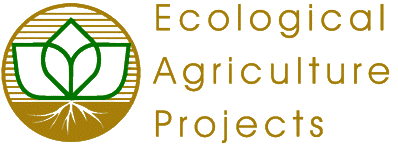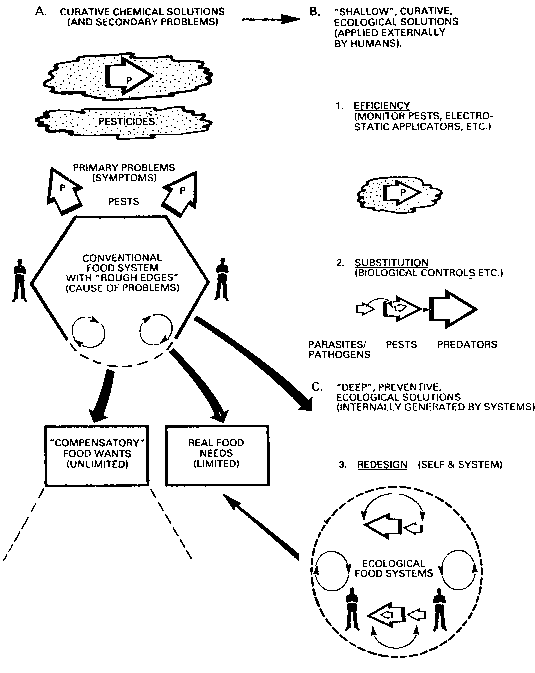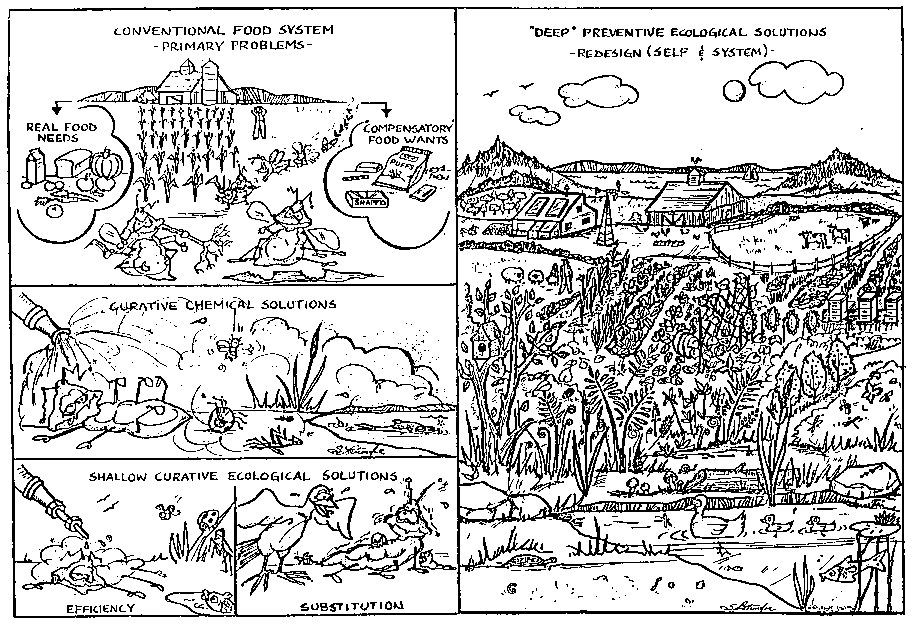

EAP Publications | Virtual Library | Magazine Rack | Search
Join the Ecological Solutions RoundtableEAP Publication - 3
by Dr. Stuart B. Hill, Dept. of Entomology and Ecological Agriculture Projects, Macdonald College, McGill University, Canada
One of the major requirements of a biological response to the problems of pesticides raised by the PAN Campaign is a reliable, scientifically sound system for pest control. This paper is revolutionary in its approach to pest control, and is one expression of a shift in fundamental thinking that is currently taking place within science. It deals with the subject in a broader way than is usual, incorporating, in particular, the latest insights from our understanding of human behavior. More specifically, it calls for identifying and confronting the real causes of pest problems, and of abandoning, once and for all, the common practice of merely treating the symptoms.
Many of the causes of pest problems lie outside of the realm of the disciplines that conventionally are called upon to deal with them. Furthermore, the implementation of what is being proposed requires a new understanding of the role of individuals, and of institutions, in bringing about social change. Individuals are required to accept greater responsibility for their behavior, and society is required to be more supportive of individuals in their efforts to abandon inappropriate ("patterned, compensatory") behaviour, and to do all in their power to prevent further development of such behaviour.
Since the late 1940's pest control has become increasingly synonymous with the use of synthetic pesticides. Over 2 million metric tonnes of pesticides (active ingredients) are currently applied annually in the world: 34% in N. America, 45% in Western and Eastern Europe, and 21% elsewhere. This is more than double the amount applied 10 years ago.
Although there have been improvements in the types of chemicals used, their formulation, and methods of application, these have not reduced the inherent problems associated with their use. Indeed, some have become more serious. Most such problems derive from the fact thee nearly all pesticides are novel chemicals (having no counterparts in nature). Furthermore, because pests are economic and not biological entities, these chemicals are never specific to pests (poisons cannot be selective on a basis of economics). The main problems are thatpest pesticides and/ or their by-products are persistent and cumulative; non-specific; and difficult to apply only to target organisms; they have lethal and sub-lethal, immediate and delayed effects; and they are subject to a high incidence of misuse; their use (or misuse) is usually followed by resurgence of the pest, often to higher population levels than before; invariably the pest becomes resistant to the pesticide; and often secondary pests appear.
Why, with such a list of disadvantages, are pesticides used so widely? Pesticide use generally results in an increase in profits (or a decrease in losses); this is because our system of costbenefit analysis ignores those costs associated with the above problems (this is one of many examples of private short-term gain at public long-term expense). Alternative methods of control are not available for most pests, or are less convenient to use. A more subtle reason, however, is that most users are also subconsciously attracted to pesticides for their symbolic properties, particularly their "power symbolism". Thus, if in any citation one tends to feel powerless or vulnerable, as do most people at one time or another, then there is a tendency to be subconsciously attracted to "compensatory" external symbols of power, e.g., through one's possessions, occupation, social position, pastimes, etc. Such behaviour tends to be predictably repeated or patterned, and it never leads to lasting satisfaction. Because pesticides are perceived as powerful poisons that are usually applied directly to the "enemy" by means of powerful equipment and because they have immediate predictable effects, they are prime candidates for this "compensatory" role. By contrast, the alternatives are usually presented as "gentle" techniques; they are often more complicated to use, and are less certain of their effects. Such effects may occur via indirect pathways, and they often take longer to kill the pests than do most pesticides. I believe that this largely explains why those alternative techniques that are superior to chemicals in terms of their cost-benefit analysis remain neglected. It also explains some of the tensions we experience when our "common sense" tells us to do one thing but some, usually unacknowledged, force seems to drive us to ignore such "inner Wisdom".
Thus, I start from the premise that pest control methods are used, and even the research on them is conducted, not within an objective scientific framework, but within a highly subjective, personal framework. This type of situation does not just apply to pest control, but to every part of the food system, indeed to every aspect of our lives. With this insight it becomes easier to understand why, within the food system (and also in most other "industries"), the primary goals are productivity, profit and power. These have no built-in limits; they are associated with growth, competition and centralization, exhaustion of non-renewable resources, the destruction of renewable resources and, within our own species, with stress, detachment and degeneration. More appropriate goals would be nourishment (taking into account quality as well as quantity and unique individual needs), fulfillment, evolution and sustainability. These have built-in limits: they are associated with balance, cooperation and decentralization, minimal dependence on non-renewables and minimal impact on renewables. Humans working within such systems are more likely to experience joy, a sense of integration or oneness with the earth, its inhabitants and one another, and a feeling of developing nearer and nearer to one's full potential as time progresses. It is within this latter type of framework that the following alternative methods of pest control are likely to reach their full potential
Efforts to introduce alternatives may be conveniently grouped into three approaches: "efficiency ", "substitution and "redesign" (Fig. 1).

Integrated pest management (IPM) combines techniques that largely fall within the first two approaches together with the use of pesticides. IPM's first requirement is access to accurate techniques for monitoring pests (and, ideally, also their natural controls). Monitoring techniques include routine examination of the crop and the crop examination of the crop environment, simple methods such as 'jarring', sweeping with a net, interception traps, and traps that incorporate attractants, such as pheromones or sex attractants. These latter are also sometimes used as control measures, particularly to disrupt the normal mating behaviour of certain pests. Other ways to increase the efficiency with which pesticides are used include better formulation and methods of application (e. g. electrostatic applicators), and access to economic threshold data for each of the pests. The requirement for pesticides can also be reduced by using resistant crop varieties, and by trapping the pests.
The "substitution~ approach involves the replacement of highly toxic, persistent, non-specific pesticides with less harmful products or, more preferably, with biological controls (parasites, predators and pathogens of the pests). Parasites include parasitic wasps, and certain flies and nematodes. Examples of predators are ladybird, ground and rove beetles, lacewing larvae, certain wasps, flies, spiders and their relatives, birds, and many others. Pathogens include bacteria, fungi, viruses, and protozoa.
Flooding pest populations with sterile or genetically incompatible males has proved effective for controlling certain pest species, particularly for isolated populations. Efforts to find more specific and safer pesticides has led to the investigation of new botanical pesticides, hormones, sterilants and contraceptives, and also the reexamination of abrasive and sorbative dusts, such as diatomaceous earth, particularly for insects in stored grain and in buildings
Alternatives mentioned up to this point, although potentially superior to non-specific toxic chemicals, share one important flaw w ith the latter. As they are primarily used in a curative way, the more effective they are, the more they will protect and perpetuate those features of the agricultural system that are the underlying causes of pest problems. Because of this, I regard them as "shallow" ecological approaches. They are external solutions to internal problems.
"Deep" ecological solutions comprise the components of the "redesign" approach - the only approach that I advocate for the future. This is because it incorporates the kind of value change referred to AA r A_ . t p ctu _ s u ~' -- pi within, rather than on the outside, of the food system; and it seeks to solve problems internally by accommodating and supporting the system's natural homeostatic processes, rather than reIying on the repeated application of increasingly ineffective cures to inappropriately designed, malfunctioning systems.
The roots of this "redesign" strategy are to be found in "cultural" methods of pest control, such as habitat modification, soil management, the use of trap crops, crop rotation, intercropping, and the use of flowers to provide pollen and nectar for certain parasites and predators of pests. The "redesign" approach, however, is still in its infancy, and is associated with a confusing array of prefixes to agaculture such as "ecological", "regenerative", "sustainable", or "permanent";= (permaculture). Sustainable solutions that have been successfully implemented tend to be of a lower power nature, and operate via indirect pathways, and over a long time frame, i.e., their characteristics are the opposite of pesticides. Although the limited funds available for food system research should be directed towards such approaches, it is already clear that the most important factor limiting the development of the redesign approach is the degree to which most humans are presently operating in a distressed (unaware) state, under the control of subconscious patterned ("compensatory") behaviours. Indeed, at the present time, such behaviours are so widespread that they are likely to sabotage all efforts to research or develop "redesign" approaches. In this sense, "redesign. at the individual level is a prerequisite to "redesign" within the agroecosystem. It is only in the context of awareness that relevant research is likely to be conducted, and that appropriate food system designs are likely to evolve.
The development of "deep" ecological approaches requires us to start to identify the driving and restraining forces that are operating, and to work to strengthen the former and weaken the latter. On a personal level this transformational process involves developing a sense of integration with the earth, and paying attention to the processes of balance and feedback. It involves studying how natural systems function, spending time with them, and learning to imitate them. But, more important, it involves paying much more attention to one's own behaviour, learning to recognize one's "compensatory" patterns, and then learning how to shed them. This is the true basis of a holistic approach. It recognizes that the way we control pests is just one expression of the way in which we conduct our lives and that by changing the general way we do things, the way we behave, we will change the way we control pests (and, in fact, the way we do everything). The development of this approach will not only affect the future of pest control but, more importantly, the evolution of our species; and by supporting such developments it is likely that the "deep" approaches advocated here will, in their turn, become the "shallow" approaches of some future generation.

Copyright © 1984 Ecological Agriculture Projects
Info Request | Services | Become EAP Member | Site Map
Give us your comments about the EAP site
Ecological Agriculture Projects, McGill University (Macdonald
Campus)
Ste-Anne-de-Bellevue, QC, H9X 3V9 Canada
Telephone:
(514)-398-7771
Fax:
(514)-398-7621
Email: eapinfo@macdonald.mcgill.ca
To report problems or otherwise comment on the structure of this site, send mail to the Webmaster